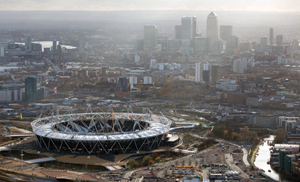Populous and Buro Happold, original architects of London Olympic Stadium, have been hired to design a retrofit of the venue to reduce seating to 60,000 with permanent clubs and concession stands.
The stadium, built with 80,000 seats, awaits a decision on who will become its primary tenant when it reopens in its post-Olympics incarnation in 2014.
 |
The entity overseeing the stadium redevelopment is set to pick a post-Olympics tenant in May.
Photo by: LOCOG |
Olympic Park Legacy Co., the government entity in charge of the legacy project, had received 16 expressions of interest by the end of January for redeveloping the stadium. More detailed proposals are due March 23, and the group is to make a final decision by May, less than three months before the Olympics, said Andreas Christophorou, Olympic Park Legacy’s spokesman.
The legacy company had agreed to sell the stadium post-Olympics to West Hamilton United, which plays in the Football League Championship division, a tier below the English Premier League. A few legal challenges, including one filed by Tottenham Hotspur, an English Premier League club and the losing bidder to West Ham, forced Olympic Park Legacy Co. to restart the process in December to find a long-term tenant.
Christophorou refused to identify which parties had submitted expressions of interest, but soccer, rugby, cricket and concerts are potential uses post-Olympics, he said. The legacy company will own the $836 million stadium and hire an outside firm to manage the facility.
With the retrofit set for 60,000 seats, the chances are good that the stadium will also become the new national stadium for British athletics.
After the Olympics, the running track surrounding the field will remain intact for the 2017 World Athletics Championships in London. Tottenham Hotspur’s proposal would have eliminated the track, according to Tom Jones, a principal at Populous. Jones, part of the original London Olympic Stadium design team, remains busy “running feasibility studies in parallel” with Olympic Park Legacy for the proposals under consideration. “Over the next few months, it will evolve into a final design,” Jones said.
West Ham remains interested in becoming the stadium’s primary tenant, according to British newspaper reports, but the team wants a share of stadium naming rights and wants a seat at the table for redeveloping the facility, among other stipulations. The legacy company is marketing naming rights, and no deal has been announced.
Olympic Park Legacy Co. has $118 million to pay for the retrofit, which includes $55 million from the Olympics budget set aside for redevelopment. The balance comes from a local government group in exchange for a financial stake in the stadium, Christophorou said. Under the original West Ham deal, the cost was pegged at $153 million to convert the stadium after the Olympics, according to local reports. The total investment will not be known until the legacy group selects a tenant, he said.
The legacy project covers eight permanent Olympic venues, including the Olympic Village and the press and broadcast center.
Over the next 20 years, the plan is to develop five neighborhoods with 8,000 new homes within the Olympics footprint. The entire project is expected to revitalize what used to be a “wasteland, heavily polluted,” before the Olympics took root, Christophorou said.
For Populous, the sustainable aspect of redesigning London Olympic Stadium falls in line with stadiums it designed for the 2014 Winter Olympics in Sochi, Russia, and the 2014 Asian Games in Incheon, South Korea, Jones said.
The Sochi facility has the flexibility to hold 32,000 spectators for the Olympics with temporary seats added to push capacity to 45,000 for 2018 World Cup soccer. After those two events, the stadium will permanently shrink to 25,000 for club soccer.
The South Korean venue will seat 70,000 for the Asian Games before being reduced to a 30,000-seat, single-side grandstand facility to serve the local community.




